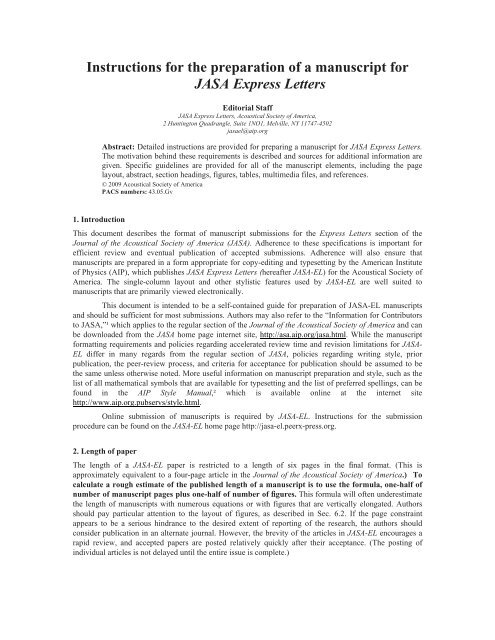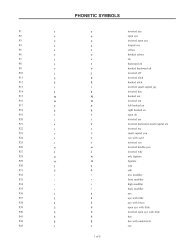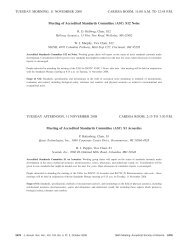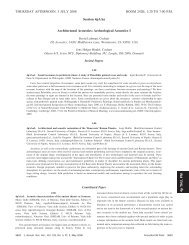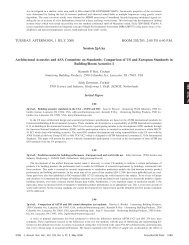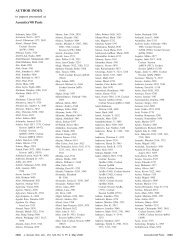Information for Contributors to JASA Express Letters - The Acoustical ...
Information for Contributors to JASA Express Letters - The Acoustical ...
Information for Contributors to JASA Express Letters - The Acoustical ...
You also want an ePaper? Increase the reach of your titles
YUMPU automatically turns print PDFs into web optimized ePapers that Google loves.
Instructions <strong>for</strong> the preparation of a manuscript <strong>for</strong><br />
<strong>JASA</strong> <strong>Express</strong> <strong>Letters</strong><br />
Edi<strong>to</strong>rial Staff<br />
<strong>JASA</strong> <strong>Express</strong> <strong>Letters</strong>, <strong>Acoustical</strong> Society of America,<br />
2 Hunting<strong>to</strong>n Quadrangle, Suite 1NO1, Melville, NY 11747-4502<br />
jasael@aip.org<br />
Abstract: Detailed instructions are provided <strong>for</strong> preparing a manuscript <strong>for</strong> <strong>JASA</strong> <strong>Express</strong> <strong>Letters</strong>.<br />
<strong>The</strong> motivation behind these requirements is described and sources <strong>for</strong> additional in<strong>for</strong>mation are<br />
given. Specific guidelines are provided <strong>for</strong> all of the manuscript elements, including the page<br />
layout, abstract, section headings, figures, tables, multimedia files, and references.<br />
© 2009 <strong>Acoustical</strong> Society of America<br />
PACS numbers: 43.05.Gv<br />
1. Introduction<br />
This document describes the <strong>for</strong>mat of manuscript submissions <strong>for</strong> the <strong>Express</strong> <strong>Letters</strong> section of the<br />
Journal of the <strong>Acoustical</strong> Society of America (<strong>JASA</strong>). Adherence <strong>to</strong> these specifications is important <strong>for</strong><br />
efficient review and eventual publication of accepted submissions. Adherence will also ensure that<br />
manuscripts are prepared in a <strong>for</strong>m appropriate <strong>for</strong> copy-editing and typesetting by the American Institute<br />
of Physics (AIP), which publishes <strong>JASA</strong> <strong>Express</strong> <strong>Letters</strong> (hereafter <strong>JASA</strong>-EL) <strong>for</strong> the <strong>Acoustical</strong> Society of<br />
America. <strong>The</strong> single-column layout and other stylistic features used by <strong>JASA</strong>-EL are well suited <strong>to</strong><br />
manuscripts that are primarily viewed electronically.<br />
This document is intended <strong>to</strong> be a self-contained guide <strong>for</strong> preparation of <strong>JASA</strong>-EL manuscripts<br />
and should be sufficient <strong>for</strong> most submissions. Authors may also refer <strong>to</strong> the “<strong>In<strong>for</strong>mation</strong> <strong>for</strong> <strong>Contribu<strong>to</strong>rs</strong><br />
<strong>to</strong> <strong>JASA</strong>,”¹ which applies <strong>to</strong> the regular section of the Journal of the <strong>Acoustical</strong> Society of America and can<br />
be downloaded from the <strong>JASA</strong> home page internet site, http://asa.aip.org/jasa.html. While the manuscript<br />
<strong>for</strong>matting requirements and policies regarding accelerated review time and revision limitations <strong>for</strong> <strong>JASA</strong>-<br />
EL differ in many regards from the regular section of <strong>JASA</strong>, policies regarding writing style, prior<br />
publication, the peer-review process, and criteria <strong>for</strong> acceptance <strong>for</strong> publication should be assumed <strong>to</strong> be<br />
the same unless otherwise noted. More useful in<strong>for</strong>mation on manuscript preparation and style, such as the<br />
list of all mathematical symbols that are available <strong>for</strong> typesetting and the list of preferred spellings, can be<br />
found in the AIP Style Manual,² which is available online at the internet site<br />
http://www.aip.org.pubservs/style.html.<br />
Online submission of manuscripts is required by <strong>JASA</strong>-EL. Instructions <strong>for</strong> the submission<br />
procedure can be found on the <strong>JASA</strong>-EL home page http://jasa-el.peerx-press.org.<br />
2. Length of paper<br />
<strong>The</strong> length of a <strong>JASA</strong>-EL paper is restricted <strong>to</strong> a length of six pages in the final <strong>for</strong>mat. (This is<br />
approximately equivalent <strong>to</strong> a four-page article in the Journal of the <strong>Acoustical</strong> Society of America.) To<br />
calculate a rough estimate of the published length of a manuscript is <strong>to</strong> use the <strong>for</strong>mula, one-half of<br />
number of manuscript pages plus one-half of number of figures. This <strong>for</strong>mula will often underestimate<br />
the length of manuscripts with numerous equations or with figures that are vertically elongated. Authors<br />
should pay particular attention <strong>to</strong> the layout of figures, as described in Sec. 6.2. If the page constraint<br />
appears <strong>to</strong> be a serious hindrance <strong>to</strong> the desired extent of reporting of the research, the authors should<br />
consider publication in an alternate journal. However, the brevity of the articles in <strong>JASA</strong>-EL encourages a<br />
rapid review, and accepted papers are posted relatively quickly after their acceptance. (<strong>The</strong> posting of<br />
individual articles is not delayed until the entire issue is complete.)
3. Keyboarding instructions<br />
<strong>JASA</strong>-EL papers are submitted electronically. With appropriate software, the electronic file should be<br />
printable with a standard printer. Such a printed version will be used by the American Institute of Physics<br />
(AIP) in the copyediting process. It is highly important that the printed-out version have ample white space<br />
<strong>for</strong> the making of copy-editing corrections. <strong>The</strong> electronic version has <strong>to</strong> be prepared so that whatever is<br />
printed-out will correspond <strong>to</strong> the following specifications:<br />
1) It must be single sided.<br />
2) It must be configured <strong>for</strong> standard US letter paper (8.5” by 11”).<br />
3) All pages should be confined <strong>to</strong> an area not <strong>to</strong> exceed 6.5” by 9”. (One inch equals 2.54 cm.)<br />
All of the margins when printed on standard US letter paper should be at least 1”.<br />
4) <strong>The</strong> type font must be 12 pt and the line spacing must correspond <strong>to</strong> double spacing<br />
(approximately 1/3”or 0.85 cm per line of print). <strong>The</strong> fonts used <strong>for</strong> the text must be a<br />
commonly used serifed variety such as Times or Computer Modern.<br />
5) Examples of captions can be found in the articles that appear in recent issues of the Journal. If the<br />
figure will appear in black and white in the printed edition and in color online, the statement<br />
“(Color online)” should be added <strong>to</strong> the figure caption.<br />
6) <strong>The</strong> <strong>to</strong>tal list of phonetic symbols that can be used by the AIP during the typesetting process is<br />
given in a document file phonsymbol.pdf, which can be downloaded by going <strong>to</strong> the <strong>JASA</strong><br />
website, http://asa.aip.org/jasa.html and then clicking on the item List of Phonetic Symbols. <strong>The</strong><br />
table in the file gives 207 items, labelled P1 through P207, with each given descriptive names such<br />
as ''inverted aye,'' ''open aye,'' and ''schwa.'' A traditional method of including such symbols in a<br />
manuscript is <strong>to</strong> write in the symbols by hand in a hard-copy of the manuscript. <strong>The</strong> symbols are<br />
then identified in the margin by either their descriptive names or their numerical<br />
designations. This method can still be used <strong>for</strong> online submission providing that<br />
the so-marked manuscript is scanned and converted <strong>to</strong> a PDF file. <strong>The</strong> latter is what one can<br />
upload during the submission process.<br />
An alternate method is <strong>to</strong> use IPA fonts in conjunction with a word processor. <strong>The</strong> IPA fonts<br />
should correspond <strong>to</strong> the International Phonetic Alphabet (IPA), which is maintained by the<br />
International Phonetics Association,whose home page is, http://www2.arts.gla.ac.uk/IPA/ipa.html.<br />
<strong>The</strong> display of the alphabet (1993, updated 1996) can be found at a variety<br />
of sites that are reached from the Association's home page. This site also<br />
provides links <strong>to</strong> some sources where one can obtain IPA fonts. It should be noted that the<br />
portability of documents prepared using IPA fonts on individual computer systems is not<br />
guaranteed. However, if a document prepared using such fonts is converted <strong>to</strong> PDF be<strong>for</strong>e<br />
submission, and if the fonts are embedded in the PDF file, no problems are anticipated. Tests<br />
made <strong>to</strong> date on the uploading of manuscripts in either MS Word or LaTeX have achieved<br />
successful conversions at the PXP site when the fonts in use are the SIL IPA93 fonts (<strong>for</strong> MS<br />
Word) and the TIPA fonts (<strong>for</strong> LaTeX). In any event, authors should check the converted files<br />
carefully after the uploading <strong>to</strong> make sure that the symbols in the converted manuscript are as<br />
intended. A fuller discussion of these fonts and of how <strong>to</strong> use IPA fonts in preparing manuscripts<br />
<strong>for</strong> online submission <strong>to</strong> the Journal is given in a supplementary document. To download this<br />
document, go <strong>to</strong> http://asa.aip.org/jasa.html. and then click on the item Use of IPA Fonts.<br />
7) Manuscript pages must be numbered consecutively, with the title page being page 1.<br />
4. Order of pages<br />
<strong>The</strong> manuscript pages must appear in the following order:<br />
1) Title page. (This includes the title, the list of authors, their affiliations, with the complete<br />
affiliations <strong>for</strong> each author appearing immediately after the author’s name, an abbreviated title <strong>for</strong><br />
use as a running title in the published version, and any appropriate footlines <strong>to</strong> title or authors.)<br />
2) Abstract page. (This includes the abstract with a separate line listing the Section 43Acoustics<br />
PACS numbers, referred <strong>to</strong> briefly in what follows as ASA-PACS, that apply <strong>to</strong> the manuscript.
<strong>The</strong> selected PACS numbers should be taken only from the appendix concerned with acoustics of<br />
the overall PACS listing. <strong>The</strong> order of the listing should be such that the principal PACS number<br />
is first.) Please note that <strong>JASA</strong>-EL requires the abstract be typed double spaced, just as <strong>for</strong> all of<br />
the remainder of the manuscript. If there is no risk of crowding, the abstract and the PACS<br />
numbers may appear on the same page as the title.<br />
3) Text of the article.<br />
4) Acknowledgments.<br />
5) Textual footnotes. (Allowed only if the paper cites references by author name and year of<br />
publication.)<br />
6) References. (If the paper cites references by labeling them with numbers according <strong>to</strong> the order in<br />
which they appear, this section will also include textual footnotes.)<br />
7) Tables, each on a separate page and each with a caption that is placed above the table.<br />
8) Collected figure captions.<br />
9) If the manuscript is submitted in PDF <strong>for</strong>m, the final pages of the uploaded manuscript can include<br />
the figures, each on a separate page, and each in PDF <strong>for</strong>mat. However, each figure must be<br />
submitted in a separate file as described in 6.2 below.<br />
5. Details of typographical style<br />
5.1 Title<br />
<strong>The</strong> title should be typed lower case with only the first word and proper names capitalized. Acronyms and<br />
wording explicitly <strong>to</strong>uting novelty are not allowed. <strong>The</strong> title should not exceed 15 words.<br />
5.2 Author name(s)<br />
Author names should appear as used <strong>for</strong> conventional publication, with first and middle names or initials<br />
followed by surname. Every ef<strong>for</strong>t should be made <strong>to</strong> keep author names consistent from one paper <strong>to</strong> the<br />
next.<br />
5.3 Author affiliation(s)<br />
Author affiliations should be separated from the next author name by an extra blank line. Affiliations<br />
should follow the <strong>for</strong>mat: division, organization, address. Abbreviations should not be used. If multiple<br />
authors have the same affiliation, one listing of the affiliation should be used, preceded by the full list of the<br />
authors. <strong>The</strong> e-mail address of all authors corresponding <strong>to</strong> each affiliation should be given below the<br />
affiliation.<br />
5.4 Running title<br />
<strong>The</strong> running title must be six words or less. No acronyms are allowed.<br />
5.5 Abstract<br />
<strong>The</strong> abstract is limited <strong>to</strong> 100 words, and must contain no personal pronouns. It must be an explicit<br />
description of the paper that states the problem, the methods used, and the nature of the results. It also<br />
should include relevant key words that would allow it <strong>to</strong> be found in a cursory computerized search. If<br />
another paper needs <strong>to</strong> be cited in the abstract, the citation should be embedded within the text of the<br />
abstract. <strong>The</strong> abstract must be a single paragraph and have no footnotes.<br />
5.6 Copyright year<br />
<strong>The</strong> line immediately following the abstract should read:<br />
© ‘‘year’’<strong>Acoustical</strong> Society of America [e.g. ‘‘year’’=2006]<br />
5.7 PACS subject classification<br />
Immediately following the abstract and on the same page, with an extra line intervening, authors should<br />
have a separate line that begins with words ‘‘PACS numbers:’’ and which is followed by up <strong>to</strong> three items<br />
of the <strong>for</strong>m 43.nn.Aa, where nn is a two digit number, A is a capital letter, and a is a lower case letter.<br />
<strong>The</strong>se items correspond <strong>to</strong> the Physics and Astronomy Classification Scheme (PACS) maintained by the
American Institute of Physics. An extended version of the section 43 listing appears as an appendix <strong>to</strong> the<br />
AIP document, and this is here referred <strong>to</strong> as the ASA-PACS system. <strong>The</strong> ASA-PACS listing can be found<br />
at the internet site http://www.aip.org/pacs/pacs08/acoustics_appendix.html. It is the authors’ responsibility<br />
<strong>to</strong> identify a principal ASA-PACS number corresponding <strong>to</strong> the subject matter of the manuscript and also<br />
<strong>to</strong> identify all other ASA-PACS numbers (up <strong>to</strong> a <strong>to</strong>tal of four) that apply.<br />
5.8 Section and subsection headings<br />
Research letters usually do not require the use of many headings or numbering of sections. However, if<br />
headings and numbering are used, follow the procedures described in this section. Section headings,<br />
including that of the introduction should be numbered consecutively and consistently throughout the paper<br />
in Arabic numbers. <strong>The</strong> heading itself should have an initial capital letter followed by lowercase, except <strong>for</strong><br />
proper names, acronyms, etc. Subsection headings may be numbered consecutively in Arabic numbers <strong>to</strong><br />
the right of the decimal point, with the section number <strong>to</strong> the left of the decimal point, and subsection<br />
headings should be in italics, with an initial capital letter followed by lowercase, except <strong>for</strong> proper names,<br />
acronyms, etc. Do not include references <strong>to</strong> the literature, illustrations, or tables in headings. <strong>The</strong>re should<br />
be extra blank lines above and below each heading. Numbering of section headings and subsection<br />
headings is optional but must be used consistently throughout papers in which it is applied.<br />
5.9 Equations<br />
Display equations should be on separate lines distinct from the text. Equation numbers should appear at the<br />
right-hand margin, in parentheses. For long equations, the equation number may appear on the next line.<br />
For very long equations, the right side of the equation should be broken in<strong>to</strong> approximately equal parts and<br />
aligned <strong>to</strong> the right of the equal sign. <strong>The</strong> equation number should appear only at the right-hand margin of<br />
the last line of the equation. All equations should be numbered in the order in which they appear and<br />
referenced from within the main text as Eq. (1), Eq. (2), Eq. (3), etc., with Equation spelled out in full at the<br />
beginning of a sentence. Use parentheses <strong>for</strong> in-line math of simple fractions when necessary <strong>to</strong> avoid<br />
ambiguity; <strong>for</strong> example, <strong>to</strong> distinguish between 1/(n-1) and (1/n)-1. Exceptions <strong>to</strong> this are the proper<br />
fractions such as 1/2, which are better left in this <strong>for</strong>m. Summations and integrals that appear within the<br />
text should have limits placed <strong>to</strong> the right of the symbol <strong>to</strong> maintain a uni<strong>for</strong>m line spacing in the published<br />
article.<br />
Although manuscripts with extensive mathematics are not discouraged per se, authors should keep<br />
in mind that the single-column, letter <strong>for</strong>mat <strong>JASA</strong>-EL <strong>for</strong>mat does not well accommodate a large number<br />
of equations.<br />
5.10 Acknowledgments<br />
Acknowledgments should be included be<strong>for</strong>e the References and links section of the manuscript. <strong>The</strong><br />
section title should read ‘‘Acknowledgments,’’ and be in bold face type. <strong>The</strong> acknowledgments section<br />
should not be numbered. <strong>The</strong> number of a grant or contract should be omitted unless its inclusion is<br />
required by the agency supporting the research, although a descriptive title <strong>for</strong> the research program may be<br />
given.<br />
5.11 References and links<br />
References should appear at the end of the article, in sequential or bibliographic <strong>for</strong>mats, as given in the<br />
examples below. <strong>The</strong> words ‘‘References and links’’ should head the section (which should not be<br />
numbered) in bold print followed by an extra blank line, directly above the first reference. All of the lines,<br />
even those pertaining <strong>to</strong> the same reference should be double spaced.<br />
<strong>JASA</strong>-EL uses either superscript numerical style or bibliographic style <strong>for</strong>mats <strong>for</strong> bibliographic<br />
citations. Only one style should be used throughout the paper. At the point of citation within the main text,<br />
designate the reference by a numerical ordered superscript, e.g., Jones 24<br />
, or by the last name of the authors<br />
followed by the year, e.g., [Jones and Smith, 2003]. For more than two authors one can use [Blake et al.,<br />
2001]. If the author is specifically mentioned in the sentence that cites the reference, the citation is<br />
accomplished by giving the year in parentheses immediately following the author name, e.g., Blake (2002).<br />
<strong>The</strong> items within the listing should include the names of all the authors and the title of the<br />
reference. Links are denoted by the preface http://. Authors should avoid ephemeral web links if at all<br />
possible. When available, digital object identifiers (DOIs) are preferred. References <strong>to</strong> Wikipedia are not<br />
permitted. Examples of lists in the <strong>for</strong>m in which they should appear in the submitted manuscript are given
elow:<br />
References and links [numerical style option]<br />
1<br />
R. E. Apfel and C. K. Holland, ‘‘Gauging the likelihood of cavitation from short-pulse, low duty cycle diagnostic<br />
ultrasound,’’ Ultrasound Med. Biol. 17, 179–185 (1991).<br />
2<br />
D. A. Hutchins and G. Hayward, ‘‘Radiated fields of ultrasonic transducers,’’in<br />
Ultrasonic Measurement Methods, Vol. 19 of Physical Acoustics, edited by R. N.<br />
Thurs<strong>to</strong>n and A. D. Pierce (Academic Press, New York, 1990), pp. 1–80.<br />
3<br />
QuickTime movie viewer plugins <strong>for</strong> web browsers, Welcome <strong>to</strong> QuickTime (Apple<br />
Computer, 1997), http://quicktime.apple.com. (Last viewed 29 Jan. 1998.)<br />
References and links [bibliographic style option]<br />
Apple Computer (1997). ‘‘QuickTime movie viewer plugins <strong>for</strong> web browsers,’’ Welcome <strong>to</strong> QuickTime, http://<br />
quicktime.apple.com. (Last viewed 29 Jan. 1998.)<br />
Bacon, S. P., and Viemeister, N. F. (1994). ‘‘Intensity discrimination and increment detection at 16 kHz,’’ J. Acoust.<br />
Soc. Am. 95, 2616–2621.<br />
Smith,R.L.(1988). ‘‘Encoding of sound intensity by audi<strong>to</strong>ry neurons,’’ in Audi<strong>to</strong>ry Function: Neurobiological<br />
Basis of Hearing, edited by G. Edelmann, W. Gall, and M. Cowan (Wiley, New York).<br />
Unlike multimedia material in the text (see Section 6.4), WWW URLs in the references will not be<br />
active in the posted online publication. (Clicking on a URL given in a reference will not take the reader <strong>to</strong><br />
that URL.)<br />
Since manuscripts <strong>for</strong> <strong>JASA</strong>-EL are concise descriptions of recent research, lengthy literature<br />
reviews are inappropriate. References should be chosen carefully and limited <strong>to</strong> those with a close<br />
connection <strong>to</strong> the manuscript. A reference list longer than roughly 10 items may indicate that a manuscript<br />
is inappropriate <strong>for</strong> <strong>JASA</strong>-EL.<br />
6. Figures (including multimedia) and tables<br />
6.1 Tables<br />
Tables are numbered by Arabic numerals (Table 3, Table 4, etc.) and are collected at the end of the<br />
manuscript, following the references and preceding the figure captions, one table per page. <strong>The</strong>re should be<br />
a descriptive caption above each table in the manuscript. Use horizontal lines in tables <strong>to</strong> delimit the <strong>to</strong>p<br />
and bot<strong>to</strong>m of the table and column headings. Tables are referred <strong>to</strong> in the manuscript text as Table 1, Table<br />
2, etc.<br />
Footnotes <strong>to</strong> individual items in a table are designated by raised lower case letters (0.123 a<br />
, Martin b<br />
,<br />
etc.) <strong>The</strong> footnotes as such are given below the table and should be as brief as practicable. If the footnotes<br />
are <strong>to</strong> references already cited in the text, then they should have <strong>for</strong>ms such as— a<br />
Reference 10—or—<br />
b<br />
Fires<strong>to</strong>ne (1935)—depending on the citation style adopted in the text.<br />
Due <strong>to</strong> the concise nature of <strong>JASA</strong>-EL manuscripts, they should generally have two tables or less.<br />
Submissions with more than three tables must receive permission from the Edi<strong>to</strong>r.<br />
6.2 Figures<br />
Each figure should be in a separate electronic file. <strong>The</strong> allowable <strong>for</strong>mats are TIFF, PS, EPS, or PDF <strong>for</strong>mat;<br />
one file <strong>for</strong> each cited figure number. Pho<strong>to</strong>graphs must be converted <strong>to</strong> electronic <strong>for</strong>m and presented as<br />
separate files. <strong>The</strong> inclusion of figures interspaced with the text of the submitted manuscripts leads <strong>to</strong> an<br />
undesirable risk of confusion when the manuscript is typeset <strong>for</strong> publication. For the review process, the<br />
PXP system will au<strong>to</strong>matically convert each figure <strong>to</strong> PDF and append these in numerical order <strong>to</strong> a<br />
converted PDF file of the text of the manuscript. Captions should be collected and typed on one or more<br />
double-spaced pages which follow the text of the manuscript. In the caption list, the figures should be<br />
numbered consecutively (i.e., not by section) with Arabic numbers. <strong>The</strong> detail in any figure should be<br />
commensurate with the space it will occupy in the published paper.<br />
Due <strong>to</strong> the concise nature of <strong>JASA</strong>-EL manuscripts, they should generally have three figures or less.<br />
Submissions with more than four figures must receive permission from the Edi<strong>to</strong>r. Authors are strongly<br />
encouraged <strong>to</strong> submit figures with a wide aspect ratio (ratio of horizontal <strong>to</strong> vertical dimensions), such as
2:1. Such figures fit the wide, single-column <strong>for</strong>mat of <strong>JASA</strong>-EL better than narrower figures (aspect ratios<br />
approximately 4:3) produced by the default settings of many common graphics packages. <strong>The</strong> latter, while<br />
well suited <strong>to</strong> regular <strong>JASA</strong>, result in substantial white space on each side of the figure in <strong>JASA</strong>-EL. If a<br />
nearly square figure is desired, authors should consider placing two such figures side-by-side and labeling<br />
them parts (a) and (b).<br />
<strong>JASA</strong>-EL will accept multimedia files (e.g., video and audio) as separate files. Specific instructions<br />
<strong>for</strong> submitting multimedia files are described in Section 6.4 below.<br />
6.3 Use of color and gray scales<br />
Color figures may be used when they convey in<strong>for</strong>mation difficult <strong>to</strong> portray in black and white or gray<br />
scale. To facilitate interpretation in black-and-white printed versions, lines on graphs should ordinarily be<br />
distinguished by different line styles or symbols. Authors should print their color figures in black and white<br />
<strong>to</strong> determine whether they remain intelligible. If interpretation of the figure is unclear in black and white,<br />
authors are expected <strong>to</strong> pay <strong>for</strong> color in the printed version. (See following paragraph.) Figure captions may<br />
refer <strong>to</strong> color only if the printed version appears in color.<br />
Color figures are published online without additional charge. Unless requested by the author(s),<br />
the color figures will be printed in gray scale in the printed version of <strong>JASA</strong>. If color printing is desired or<br />
necessary <strong>for</strong> interpretation of the figure, additional charges <strong>for</strong> color artwork in the printed edition of<br />
<strong>JASA</strong> will apply and payment is manda<strong>to</strong>ry. <strong>The</strong> charges incurred by inclusion of color figures in the print<br />
version of the Journal are difficult <strong>to</strong> estimate, and are determined by the printer on a case-by-case basis.<br />
<strong>The</strong>y may be as large as $1000 per page.<br />
6.4 Multimedia files<br />
A benefit of publishing in an online journal is the ability <strong>to</strong> integrate multimedia files in<strong>to</strong> both the<br />
published and archived articles. <strong>The</strong> online presentation of the paper allows <strong>for</strong> links <strong>to</strong> both audio and<br />
video clips directly from within the text of the article. <strong>The</strong> multimedia files submitted <strong>for</strong> <strong>JASA</strong> <strong>Express</strong><br />
<strong>Letters</strong> (<strong>JASA</strong>-EL) will be reviewed as part of the peer review process and accepted <strong>for</strong> publication in much<br />
the same way as are 2-dimensional figures <strong>for</strong> traditional print journals. <strong>The</strong> multimedia submission<br />
guidelines presented here are subject <strong>to</strong> change because of improvements and increasing availability of the<br />
relevant technology. Queries concerning the present status of the PXP system <strong>for</strong> submission of multimedia<br />
files can be addressed <strong>to</strong> jasael@aip.org.<br />
<strong>The</strong> implementation of <strong>JASA</strong>-EL on the Peer X-Press system is intended <strong>to</strong> be such that<br />
multimedia files are submitted in the same manner as are figure files, and that they are uploaded<br />
individually during the manuscript submission process. <strong>The</strong> sequence in which they are uploaded should be<br />
the same as that in which they are referred <strong>to</strong> in the text. <strong>The</strong> text should refer <strong>to</strong> these files using the<br />
designations Mm. 1, Mm. 2, etc.; this is similar <strong>to</strong> the convention of referring <strong>to</strong> figures as Fig. 1, Fig. 2, etc.<br />
To ensure broad viewing/playing ability across hardware plat<strong>for</strong>ms and browsers, submissions in a<br />
variety of file <strong>for</strong>mats are acceptable.<br />
Acceptable video <strong>for</strong>mats are: (i) QuickTime movies (mov); (ii) Mpeg movies (mpg);<br />
(iii) Animated Gifs (gif); (iv) Audio Video Interleave (avi)<br />
Acceptable audio <strong>for</strong>mats are: (i) AIFF (aif); (ii) Au (au); (iii) Wav (wav); (iv) Nonstreaming<br />
Real Audio (ra)<br />
In the above lists, the letters in parentheses are the standard endings <strong>for</strong> files in the corresponding<br />
<strong>for</strong>mat. For example, fancymovie.mov would be a file containing a QuickTime movie.<br />
It is important that authors make their multimedia files no larger or numerous than necessary <strong>to</strong><br />
convey scientific in<strong>for</strong>mation that is central <strong>to</strong> the manuscript's purpose. Authors should consider that files<br />
larger than several MB are problematic <strong>for</strong> readers using dial-up connections. Files larger than 10 MB<br />
require permission from the Edi<strong>to</strong>r. When video compression is used, the codec software module must be<br />
widely available. Files may not be compressed in<strong>to</strong> archives, such as .zip and .tar <strong>for</strong>mats. Since readers<br />
may find it tedious <strong>to</strong> download numerous files that contribute little new in<strong>for</strong>mation, authors must select<br />
their materials carefully. Submissions with more than 4 multimedia files must receive permission from the<br />
Edi<strong>to</strong>r.<br />
In the typesetting of an accepted manuscript, links will be placed within the online publication <strong>for</strong><br />
each of the multimedia files. During the peer-review process, the reviewers and edi<strong>to</strong>rs will access such<br />
files by going <strong>to</strong> the online site reserved <strong>for</strong> the submitted manuscript and its accompanying files, and then
selecting whatever multimedia file is desired.<br />
To help the publishers in determining just where links <strong>to</strong> each multimedia file are <strong>to</strong> be placed,<br />
authors should give a multimedia caption following the first paragraph in which the file is mentioned. <strong>The</strong><br />
multimedia caption should resemble the following example:<br />
Mm. 2. Fancy video file. This is a file of type ‘‘mov’’ (1.2 Mb).<br />
Here “Fancy video file” is the caption <strong>for</strong> the multimedia object, which contains a level of<br />
description similar <strong>to</strong> a figure or table caption. <strong>The</strong> primary purpose of including the file type and its size is<br />
<strong>to</strong> allow readers <strong>to</strong> determine whether they wish <strong>to</strong> download it.<br />
Authors may also wish <strong>to</strong> have a figure included <strong>for</strong> each of the video files that accompany the<br />
manuscript. One way of doing this is <strong>to</strong> take a single frame and convert it <strong>to</strong> a figure file, and then treat this<br />
in the same way as one would treat any other figure. However, the caption <strong>for</strong> such a figure should refer <strong>to</strong><br />
the Mm number of the corresponding video file and should give a brief description of what can be found in<br />
that file.<br />
References<br />
1<br />
<strong>Acoustical</strong> Society of America, <strong>In<strong>for</strong>mation</strong> <strong>for</strong> <strong>Contribu<strong>to</strong>rs</strong> <strong>to</strong> the Journal of the <strong>Acoustical</strong> Society of America (<strong>JASA</strong>)<br />
(<strong>Acoustical</strong> Society of America, 2 Hunting<strong>to</strong>n Quadrangle, Suite 1NO1, Melville, NY 11747, 1990, 4th ed.). This is frequently<br />
revised; it appears in the front matter of the January and July issues of the Journal of the <strong>Acoustical</strong> Society of America; the<br />
most current version can be found online at http://asa.aip.org/jasa.html.<br />
2<br />
AIP Publication Board (R. T. Beyer, chair), AIP Style Manual (American Institute of Physics, 2 Hunting<strong>to</strong>n Quadrangle, Suite<br />
1NO1, Melville, NY 11747, 1990, 4th ed.). This is available online at http://www.aip.org/epub/ styman.html.<br />
3<br />
American Institute of Physics, Physics and Astronomy Classification Scheme 2003. A paper copy is available from Scientific<br />
Classification Section, American Institute of Physics, 2 Hunting<strong>to</strong>n Quadrangle, Suite 1NO1, Melville, NY 11747. It is also<br />
available online at the site http://www.aip.org/pacs/pacs03/ appendix.html


